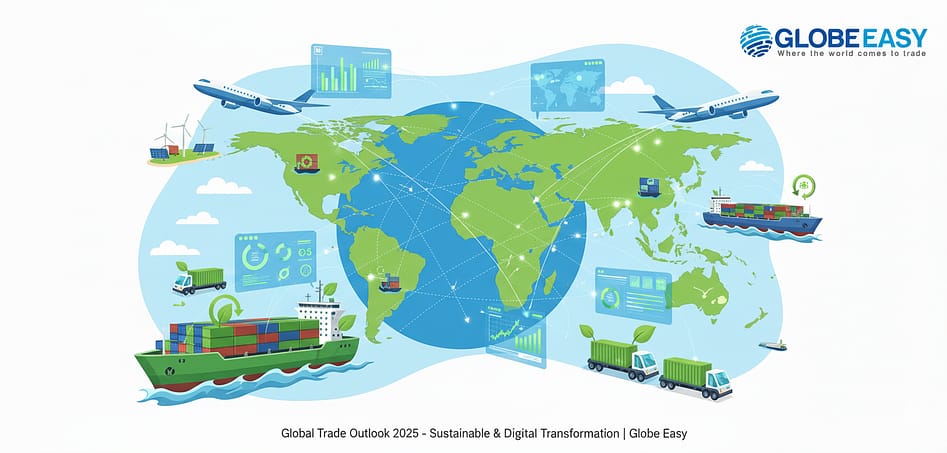Blog
Global Trade Outlook 2025: How Technology & Sustainability Are Redefining Exports
Introduction
As we step into 2025, global trade is undergoing a massive shift driven by technology, sustainability, and supply chain resilience. Businesses worldwide are rethinking sourcing, manufacturing, and logistics to adapt to new realities shaped by AI-driven platforms, ESG mandates, and eco-friendly production. For exporters and importers alike, the key to success now lies in digital adaptation and sustainable trade practices.
1. The Rise of Digital B2B Marketplaces
Gone are the days when trade relied solely on exhibitions and manual sourcing. In 2025, AI-powered B2B platforms like Globe Easy are transforming global commerce by connecting verified buyers, suppliers, and service providers seamlessly. These platforms now offer integrated logistics, payments, certification, and trade finance — empowering exporters to reach new markets faster.
Trend Insight:
According to recent trade data, over 60% of cross-border B2B transactions are now initiated online, signaling a major digital transformation in global exports.
2. Sustainable Trade Becomes a Global Standard
Sustainability is no longer optional — it’s a trade requirement. With new carbon tax laws and green import policies in the EU, US, and Japan, exporters must demonstrate compliance with ESG (Environmental, Social, Governance) norms.
Eco-friendly packaging, recyclable materials, and carbon-neutral logistics are now in high demand. Indian manufacturers, for example, are investing heavily in biodegradable products and renewable energy-based production, positioning themselves as global leaders in green trade.
Globe Easy Insight:
Platforms that help exporters get eco-certifications, source sustainable raw materials, and meet buyer compliance will dominate the trade ecosystem by 2026.
3. AI, Blockchain, and Smart Trade Systems
Technology is the new backbone of trade. Blockchain ensures transparency and trust in transactions, while AI-driven analytics predict demand patterns and optimize pricing. IoT-based logistics are improving supply chain visibility, reducing delays, and cutting costs.
For exporters, adopting digital trade documents, automated invoicing, and smart contracts means faster clearance and fewer disputes. Governments, too, are introducing paperless trade systems to accelerate exports — a major advantage for SMEs.
4. Regional Trade Shifts & New Opportunities
Geopolitical dynamics continue to shape trade routes. With India emerging as a manufacturing alternative to China, new opportunities are opening in textiles, electronics, pharmaceuticals, and eco-friendly goods.
Africa, the Middle East, and Southeast Asia are becoming key growth destinations due to rapid digitalization and infrastructure investments. For businesses focusing on sustainable and affordable products, these regions offer untapped potential in 2025 and beyond.
5. The Future Is Collaborative & Transparent
The next phase of global trade will revolve around collaboration, trust, and traceability. Platforms that integrate exporters, logistics partners, banks, and compliance agencies under one ecosystem will define the future of trade.
Globe Easy’s model — combining B2B marketplace, trade services, and sustainability-driven ecosystem — exemplifies this evolution. Exporters who embrace digital tools, ethical sourcing, and transparent documentation will not just survive but thrive in the new trade era.
Conclusion
2025 is the year when digital and sustainable trade converge. Exporters who adapt early will benefit from reduced costs, better market reach, and enhanced global reputation. The transformation is clear — technology and sustainability are no longer choices, they are the trade essentials.
Globe Easy is proud to stand at the forefront of this revolution — empowering businesses to go global, sustainably.



